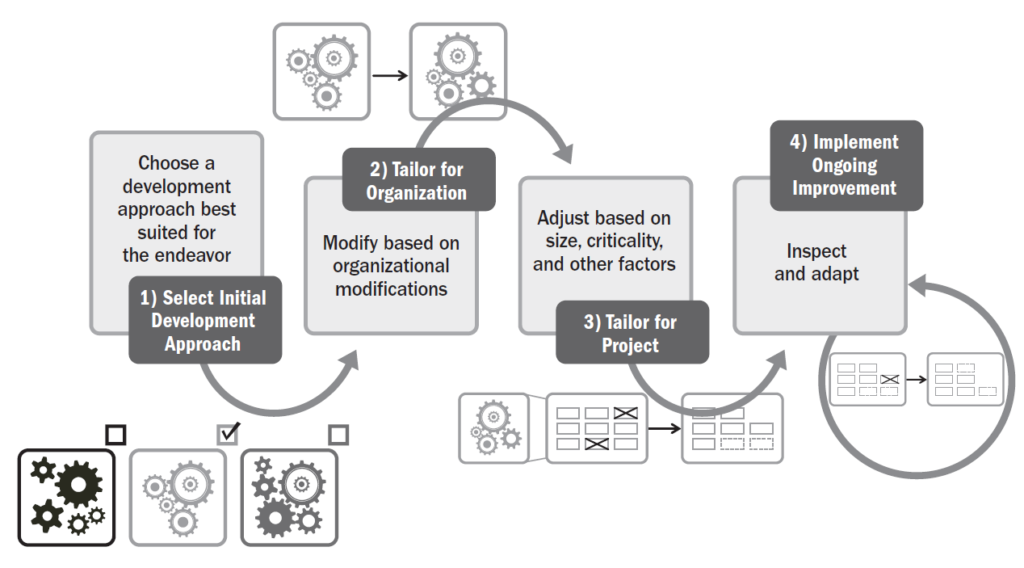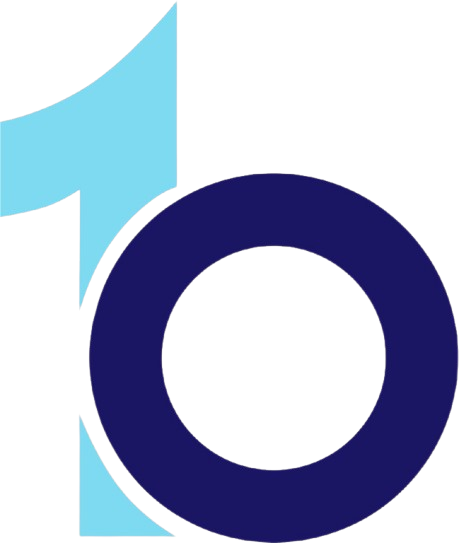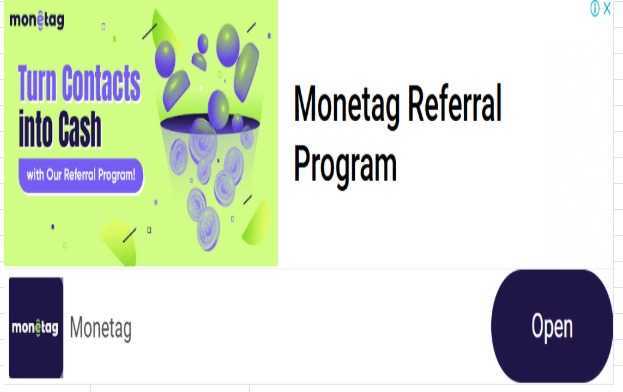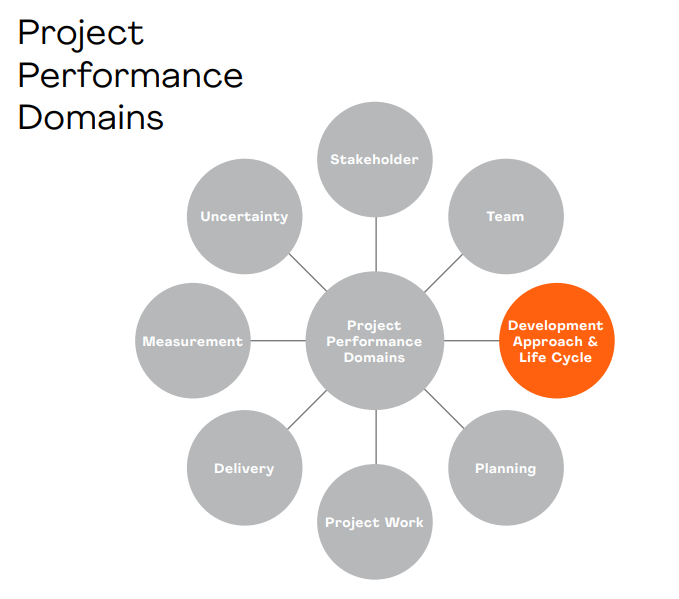Here is a comprehensive blog post on “Tailoring the Performance Domains – Development Approach and Life Cycle” based on the PMBOK® Guide (7th Edition), tailored for an in-depth blog of over 3000 words.
Tailoring the Performance Domains – Development Approach and Life Cycle
In project management, every decision—from strategy to execution—is shaped by the context of the project. One of the most impactful decisions lies in choosing and tailoring the Development Approach and Life Cycle, a core performance domain outlined in the PMBOK® Guide (7th Edition). This domain significantly influences how the project will unfold, how value will be delivered, and how the team and stakeholders will interact throughout the journey.
This blog explores how project managers and teams can tailor the development approach and life cycle to align with project objectives, complexity, uncertainty, and stakeholder needs.
Understanding the Development Approach and Life Cycle Performance Domain
The Development Approach and Life Cycle Performance Domain involves defining how the work of the project will be delivered. It encompasses decisions related to:
- Development approach (predictive, agile, hybrid, or incremental)
- Life cycle phases (e.g., initiating, planning, executing, closing)
- Governance and review mechanisms
- Decision points and deliverables
- Transition and handover processes
The PMBOK® Guide emphasizes that tailoring this domain ensures that the selected method aligns with both the internal and external environment of the project.
Why Tailor the Development Approach and Life Cycle?
Every project is different, and so is its ideal execution strategy. Tailoring ensures:
- Alignment with Business Objectives
Tailoring helps ensure that the chosen approach maximizes value and aligns with what the business is trying to achieve. - Adaptation to Complexity and Uncertainty
Projects with high uncertainty (e.g., software development) benefit from iterative models, while well-defined projects (e.g., construction) align better with predictive models. - Improved Stakeholder Engagement
Tailoring allows you to adjust communication and deliverables according to stakeholder expectations. - Optimal Use of Resources
By aligning the life cycle with project needs, resources can be used more efficiently, reducing cost and schedule risks.
Types of Development Approaches
Tailoring often begins with choosing the most appropriate development approach. Below are the key types:
1. Predictive (Waterfall)
- Characteristics: Linear, sequential phases; clear scope and requirements from the beginning.
- Best For: Construction, engineering, legal, government projects.
2. Iterative
- Characteristics: Repeated cycles to refine and improve the product before final delivery.
- Best For: Projects where the end-product is known but not all details are clear initially.
3. Incremental
- Characteristics: Partial delivery of working components, which together form the final product.
- Best For: Product development, manufacturing, and service rollout projects.
4. Agile/Adaptive
- Characteristics: Highly flexible, customer collaboration, continuous delivery.
- Best For: Software development, R&D, marketing campaigns.
5. Hybrid
- Characteristics: Combines elements of predictive and agile.
- Best For: Complex projects with both stable and uncertain elements (e.g., ERP implementation).
Tailoring Considerations for Development Approach and Life Cycle
When tailoring this domain, consider the following aspects:
1. Project Complexity and Uncertainty
- Low Complexity: Use a predictive approach with a standard life cycle.
- High Complexity/Uncertainty: Use an agile or hybrid approach with adaptable life cycles.
2. Stakeholder Requirements
- Fixed requirements: Predictive life cycle suits these.
- Evolving requirements: Adaptive/agile allows frequent changes and feedback loops.
3. Organizational Culture and Maturity
- Tailor based on:
- Openness to change
- Comfort with experimentation
- Governance structure
- Example: A highly regulated environment may resist agile approaches without strong oversight.
4. Team Capabilities and Experience
- Teams experienced in agile methods can handle iterative planning and delivery cycles.
- Traditional teams may need training and time to adopt hybrid or agile models.
5. Technology and Tools
- Agile approaches often require tools like Jira, Trello, or Azure DevOps.
- Predictive approaches may use Microsoft Project, Excel, or Gantt charts.
6. Compliance and Risk
- Regulatory environments may necessitate structured documentation and formal approvals (predictive).
- High-risk innovation projects may benefit from agile testing and feedback loops.
Tailoring the Project Life Cycle
The project life cycle can vary significantly depending on the chosen development approach.
Tailoring Life Cycle Phases:
Phase | Predictive Tailoring | Agile Tailoring |
Initiating | Formal kickoff, stakeholder sign-offs | Lightweight planning, backlog brainstorming |
Planning | Detailed upfront planning, scope lock-in | Rolling wave planning, iterative refinements |
Executing | Following plan strictly | Sprints or iterations, continuous delivery |
Monitoring | Phase-end reviews, earned value metrics | Daily standups, sprint reviews, burn-down charts |
Closing | Formal sign-off, transition to operations | Incremental deliveries, continuous handover |
Tailoring Tip:
Avoid applying every phase rigidly. Adjust the number of phases and their intensity depending on time, budget, and team dynamics.
Tailoring Governance and Oversight
Governance should match the approach:
- Predictive: Formal stage gates, milestone reviews, sign-off checkpoints.
- Agile: Product demos, sprint reviews, retrospectives, lean governance.
Tailoring Governance Practices:
- Combine oversight with flexibility.
- In hybrid models, apply formal governance to predictive components and lighter governance to agile teams.
Tailoring Example Scenarios
Scenario 1: IT Infrastructure Project (Predictive)
- Project involves installing a new company-wide network system.
- Requirements are well-defined.
- Risks must be managed formally.
- Tailoring Outcome:
- Predictive approach with formal life cycle.
- Gated governance for each phase.
- Detailed up-front planning.
Scenario 2: E-commerce Website Redesign (Agile)
- Business needs a responsive redesign with frequent testing and user feedback.
- Requirements are evolving based on market feedback.
- Tailoring Outcome:
- Agile development using Scrum.
- Continuous integration and testing.
- Daily stand-ups, sprints, and retrospectives.
Scenario 3: ERP Implementation (Hybrid)
- Core system requirements are fixed, but front-end UX and integrations need user feedback.
- Tailoring Outcome:
- Predictive for backend and compliance aspects.
- Agile for UX/UI design and mobile integrations.
- Separate teams working in parallel with different governance models.
Best Practices for Tailoring the Development Approach and Life Cycle
- Assess Context Thoroughly
Understand the project’s complexity, stakeholder needs, and organizational constraints. - Engage Stakeholders Early
Involve clients, users, and sponsors in choosing and shaping the development approach. - Be Flexible and Iterative
Revisit and adjust the chosen approach as the project evolves. - Document Tailoring Decisions
Maintain transparency and ensure consistency across teams. - Train Teams on Tailored Methods
Equip your teams with the skills needed to operate within the selected model. - Monitor and Review
Continuously evaluate whether the tailored approach is still delivering value.
Common Mistakes to Avoid When Tailoring
- Forcing Agile in a non-agile environment without proper support.
- Over-engineering predictive models for flexible projects.
- Ignoring the need for stakeholder training in tailored approaches.
- Neglecting to revisit and update the approach when the project evolves.
Measuring Tailoring Effectiveness
You can assess the effectiveness of your tailored approach by monitoring:
- Stakeholder satisfaction
- Delivery speed and predictability
- Scope change response time
- Cost and schedule variance
- Team engagement and productivity
Use surveys, retrospectives, and lessons learned sessions to gather qualitative feedback.
Conclusion
Tailoring the Development Approach and Life Cycle is not just about picking between Agile and Waterfall. It’s about designing a delivery path that fits the project’s DNA—its complexity, people, environment, and objectives. It enables smarter decisions, faster value delivery, and stronger alignment with organizational goals.
By thoughtfully tailoring this performance domain, project managers can better manage uncertainty, enhance stakeholder satisfaction, and increase the chances of project success. After all, there’s no single “right” way—only the right way for your project.



